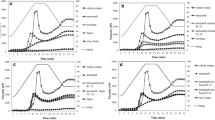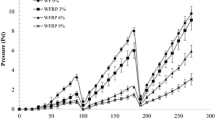Abstract
This study aims to investigate properties of whole wheat flour breads produced with the combined addition of amaranth (5, 10, and 15%) and fennel (1, 1.5, and 2%) powders. The color, texture, total phenolic content, and sensory properties of breads were determined in terms of quality and functional properties evaluation. The protein contents of whole wheat flour and amaranth powder were found as 11.55 and 13.89%, respectively. The close protein ratios, low substitution levels and simultaneous substitution of fennel powder with amaranth did not cause significant changes in protein ratios of breads. In addition, amaranth (2.36%) and fennel (7.04%) powders contain higher ash content to whole wheat flour (1.53%), and ash ratios of breads containing 10% amaranth–1.5% fennel and 15% amaranth–2% fennel increased significantly and were determined as 3% and 3.14%, respectively. The fennel also significantly increased phenolic content of bread, with a total phenolic content of 3989.19 mg GAE/100 g DW in 2% fennel-containing bread, compared to 2750.99 mg GAE/100 g DW in control bread. The darkness of crust and crumb increased with the increase in amaranth and fennel ratio. While the whiteness index of crumb decreased from 43.65 to 36.14, the browning index of crust increased from 78.36 to 92.17 with increasing substitution level. The using of gluten-free powders also affected textural properties of samples, and hardness of breads increased when amaranth and fennel ratio increased. While all breads were found acceptable in sensory evaluation, bread containing 10% amaranth and 1.5% fennel was defined as the most acceptable.



Similar content being viewed by others
References
AOAC (2005) Official Methods of Analysis of Association of Official Analytical Chemists. 18th Edition, Washington, DC.
Ayo JA (1999) Effect of heat processing on the physico-chemical and sensory qualities of’Tsire’-Suya. Int J Food Prop. https://doi.org/10.1080/10942919909524595
Bhol S, Bosco SJD (2014) Influence of malted finger millet and red kidney bean flour on quality characteristics of developed bread LWT - Food Sci Technol 55(1):294–300. https://doi.org/10.1016/j.lwt.2013.08.012
Bigliardi B, Galati F (2013) Innovation trends in the food industry: the case of functional foods. Trends Food Sci Technol. https://doi.org/10.1016/j.tifs.2013.03.006
Bilek SE (2010) The effects of time, temperature, solvent: solid ratio and solvent composition on extraction of total phenolic compound from dried olive (Olea europaea L.) leaves. Gıda 35(6):411–416
Cheftel JC, Cuq JL, Loirent D (1985) Amino acids, peptides, and proteins. Food Chem. O. Fennema (Editor), 2nd Edition, pp. 245–370. Marcel Dekker, NY.
Chlopicka J, Pasko P, Gorinstein S, Jedryas A, Zagrodzki P (2012) Total phenolic and total flavonoid content, antioxidant activity and sensory evaluation of pseudocereal breads. LWT-Food Sci Technol. https://doi.org/10.1016/j.lwt.2011.11.009
Coţovanu I, Mironeasa S (2022) Features of Bread Made from Different Amaranth Flour Fractions Partially Substituting Wheat Flour. Appl Sci 12(2):897. https://doi.org/10.3390/app12020897
Dabija A, Codină GG, Sidor AM (2017) Studies Regarding the Effect of Defatted Rapeseed Flour Addition on Wheat Flour Dough Microstructure, Rheological Properties and Bread Quality. Int Multidiscip Sci GeoConference: SGEM 17:991–997
Das L, Raychaudhuri U, Chakraborty R (2013) Herbal fortification of bread with fennel seeds. Food Sci Biotechnol 51(3):434
de Alcântara RG, de Carvalho RA, Vanin FM (2020) Evaluation of wheat flour substitution type (corn, green banana and rice flour) and concentration on local dough properties during bread baking. Food Chem 326:126972. https://doi.org/10.1016/j.foodchem.2020.126972
Đurović S, Vujanović M, Radojković M, Filipović J, Filipović V, Gašić U, Zeković Z (2020) The functional food production: Application of stinging nettle leaves and its extracts in the baking of a bread. Food Chem. https://doi.org/10.1016/j.foodchem.2019.126091
Evers AD, Rosentrater KA, (2018) Kent's Technology of Cereals: An Introduction for Students of Food Science and Agriculture. Elsevier.
Gan Z, Ellis PR, Vaughan JG, Galliard T (1989) Some effects of non-endosperm components of wheat and of added gluten on whole meal bread microstructure. J Cereal Sci 10(2):81–91
Gomez M, Ronda F, Cabellero PA, Blanco CA, Rosell C (2007) Functionality of different hydrocolloids on the quality and shellf-life of yellow layer cakes. Food Hydrocoll. https://doi.org/10.1016/j.foodhyd.2006.03.012
Gómez M, Gutkoski LC, Bravo-Núñez Á (2020) Understanding whole-wheat flour and its effect in breads: a review. Compr Rev Food Sci Food Saf. https://doi.org/10.1111/1541-4337.12625
Gómez M, Gutkoski LC, Bravo-Núñez Á (2020b) Understanding whole-wheat flour and its effect in breads: A review. Compr Rev Food Sci Food Saf 19(6):3241–3265
Haruna M, Udobi CE, Ndife J (2011) Effect of added brewers dry grain on the physico-chemical, microbial and sensory quality of wheat bread. Am J Food Nutr 1(1):39–43
Kaur S, Das M (2011) Functional foods: an overview. Food Sci Biotechnol. https://doi.org/10.1007/s10068-011-0121-7
Khalid KH, Ohm JB, Simsek S (2017) Whole wheat bread: effect of bran fractions on dough and end-product quality. J Cereal Sci 78:48–56
Liu S, Chen D, Xu J (2019) Characterization of amaranth and bean flour blends and the impact on quality of gluten-free breads. J Food Meas Charact 13(2):1440–1450. https://doi.org/10.1007/s11694-019-00060-4
Marpalle P, Sonawane SK, Arya SS (2014) Effect of flaxseed flour addition on physicochemical and sensory properties of functional bread. LWT - Food Sci Technol 58(2):614–619. https://doi.org/10.1016/j.lwt.2014.04.003
Mikulec A, Kowalski S, Sabat R, Skoczylas Ł, Tabaszewska M, Wywrocka-Gurgul A (2019) Hemp flour as a valuable component for enriching physicochemical and antioxidant properties of wheat bread. LWT 102:164–172
Miranda-Ramos KC, Sanz-Ponce N, Haros CM (2019) Evaluation of technological and nutritional quality of bread enriched with amaranth flour. LWT-Food Sci Technol. https://doi.org/10.1016/j.lwt.2019.108418
Miranda-Ramos KC, Haros CM (2020) Combined Effect of Chia Quinoa and Amaranth Incorporation on the Physico-Chemical Nutritional and Functional Quality of Fresh Bread. Foods 9(12):1859. https://doi.org/10.3390/foods9121859
Mohammed I, Ahmed AR, Senge B (2014) Effects of chickpea flour on wheat pasting properties and bread making quality. J Food Sci Technol 51(9):1902–1910. https://doi.org/10.1007/s13197-012-0733-9
Mukhtar H, Gull A, Ganaie TA, Rather SA, Masoodi FA, Ganie S (2020) Effect of supplementation of amaranth flour on various quality attributes and antioxidant activities of bread. Curr Nutr Food Sci. https://doi.org/10.2174/1573401315666190126113919
Nasir S, Allai FM, Gani M, Ganaie S, Gul K, Jabeen A, Majeed D (2020) Physical, textural, rheological, and sensory characteristics of amaranth-based wheat flour bread. Int J Food Sci. https://doi.org/10.1155/2020/88748726
Nwosu JN, Owuamanam CI, Omeire GC, Eke CC (2014) Quality parameters of bread produced from substitution of wheat flour with cassava flour using soybean as an improver. Am J Res Commun 2(3):99–118
Orona-Tamayo D, Valverde ME, Paredes-López O (2017) Chia—The new golden seed for the 21st century: Nutraceutical properties and technological uses. Academic Press, Cambridge. https://doi.org/10.1016/B978-0-12-802778-3.00017-2
Packkia-Doss PP, Chevallier S, Pare A, Le-Bail A (2019) Effect of supplementation of wheat bran on dough aeration and final bread volume. J Food Eng 252:28–35
Pathak D, Majumdar J, Raychaudhuri U, Chakraborty R (2016) Characterization of physicochemical properties in whole wheat bread after incorporation of ripe mango peel. J Food Meas Charact 10:554–561
Rosell CM, Santos E, Collar C (2010) Physical characterization of fiber-enriched bread doughs by dual mixing and temperature constraint using the Mixolab®. Eur Food Res Technol 231:535–544
Saarela M (2011) Functional foods: concept to product, 2nd edn. Elsevier, Amsterdam
Sayed-Ahmad B, Straumīte E, Šabovics M, Krūma Z, Merah O, Saad Z, Saad Z, Talou T (2017) Effect of Addition of Fennel (L.) on the Quality of Protein Bread. In Proceedings of the Latvian Academy of Sciences. Section B. Natural, Exact, and Appl Sci. 71(6) 509-514
Swami SB, Thakor NJ, Murudkar PR (2015) Effect of yeast concentration and baking temperature on quality of slice bread. J Food Res Technol 3(4):131–141
Świeca M, Sęczyk Ł, Gawlik-Dziki U, Dziki D (2014) Bread enriched with quinoa leaves–The influence of protein–phenolics interactions on the nutritional and antioxidant quality. Food Chem 162:54–62
Trejo-González AS, Loyo-González AG, Munguía-Mazariegos MR (2014) Evaluation of bread made from composite wheat-sweet potato flours. Int Food Res J 21(4):1683
Toews R, Wang N (2013) Physicochemical and functional properties of protein concentrates from pulses. Int Food Res J 52(2):445–451
Turkish Food Codex (2012) Regulation on Bread and Bread Varieties Number: 2019/29
Waters DM, Jacob F, Titze J, Arendt EK, Zannini E (2012) Fibre protein and mineral fortification of wheat bread through milled and fermented brewer’s spent grain enrichment. Eur Food Res Technol 235(5):767–778. https://doi.org/10.1007/s00217-012-1805-9
Wang Y, Jian C (2022) Sustainable plant-based ingredients as wheat flour substitutes in bread making. npj Sci Food, 6(1):49. https://doi.org/10.1038/s41538-022-00163-1
Zain MZM, Shori AB, Baba AS (2022) Potential functional food ingredients in bread and their health benefits. Biointerface Res Appl Chem. https://doi.org/10.33263/BRIAC125.65336542
Author information
Authors and Affiliations
Contributions
SE involved in conceptualization, supervision, methodology, writing—review and editing, funding acquisition, resources, and validation. BY involved in conceptualization, methodology, software, project administration, visualization, formal analysis, and investigation. AA involved in conceptualization, methodology, software, project administration, visualization, formal analysis, and investigation. RV involved in conceptualization, methodology, and writing—review and editing. ZA involved in conceptualization, methodology, and writing—review and editing. IA involved in conceptualization, methodology, and writing—review and editing. AH involved in conceptualization, methodology, and writing—review and editing. RK involved in conceptualization, methodology, and writing—review and editing. DA involved in conceptualization, methodology, and writing—review and editing.
Corresponding author
Ethics declarations
Conflict of interest
The authors declare that they have no known competing financial interests or personal relationships that could have appeared to influence the work reported in this paper.
Additional information
Communicated by Ankica Kondic-Spika.
Rights and permissions
Springer Nature or its licensor (e.g. a society or other partner) holds exclusive rights to this article under a publishing agreement with the author(s) or other rightsholder(s); author self-archiving of the accepted manuscript version of this article is solely governed by the terms of such publishing agreement and applicable law.
About this article
Cite this article
Ersus, S., Yılmaz, B., Akyüz, A. et al. The effect of amaranth and fennel addition on the physical and chemical properties of breads. CEREAL RESEARCH COMMUNICATIONS (2023). https://doi.org/10.1007/s42976-023-00431-0
Received:
Accepted:
Published:
DOI: https://doi.org/10.1007/s42976-023-00431-0




